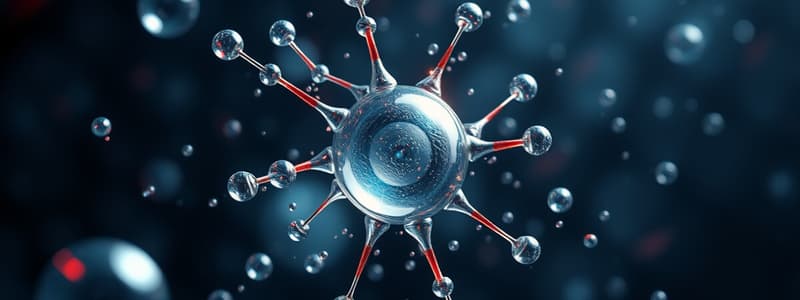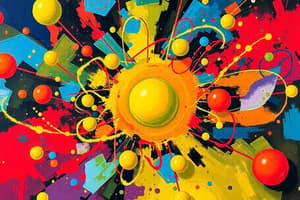Podcast
Questions and Answers
What are negatively charged, subatomic particles called?
What are negatively charged, subatomic particles called?
electrons
What elements are malleable, polish to a luster, conduct heat and electricity well, and tend to lose electrons in a chemical reaction?
What elements are malleable, polish to a luster, conduct heat and electricity well, and tend to lose electrons in a chemical reaction?
metals
What is a horizontal row on the periodic table called?
What is a horizontal row on the periodic table called?
period
What do you call two or more elements that have chemically combined?
What do you call two or more elements that have chemically combined?
What is a homogeneous mixture whose particles are too small to reflect or scatter light?
What is a homogeneous mixture whose particles are too small to reflect or scatter light?
What are positively charged, subatomic particles found in the nucleus of the atom called?
What are positively charged, subatomic particles found in the nucleus of the atom called?
What is a vertical column on the periodic table called?
What is a vertical column on the periodic table called?
What are elements with properties intermediate between those of metals and nonmetals called?
What are elements with properties intermediate between those of metals and nonmetals called?
Who first made a model of the atom called the plum pudding model?
Who first made a model of the atom called the plum pudding model?
What notion held for a long time was discredited by the findings of Henri Becquerel and the Curies?
What notion held for a long time was discredited by the findings of Henri Becquerel and the Curies?
The smallest part of an element that can still be identified as that element is a(n) _____.
The smallest part of an element that can still be identified as that element is a(n) _____.
What is a nonmagnetic, gaseous material that does not conduct heat or electricity, but reacts with other elements?
What is a nonmagnetic, gaseous material that does not conduct heat or electricity, but reacts with other elements?
What are the groupings on the periodic table made up of elements that react similarly called?
What are the groupings on the periodic table made up of elements that react similarly called?
An atom has no electrical charge because ________
An atom has no electrical charge because ________
Silicon dioxide, SiO2, is a(n) ________.
Silicon dioxide, SiO2, is a(n) ________.
The smallest unit which maintains the physical properties of a compound is a(n) ________.
The smallest unit which maintains the physical properties of a compound is a(n) ________.
What is the total number of atoms in the formula NH3?
What is the total number of atoms in the formula NH3?
A mixture requires constant shaking to keep its constituents combined. It is best described as a ________.
A mixture requires constant shaking to keep its constituents combined. It is best described as a ________.
What is liquid solution referred to as?
What is liquid solution referred to as?
What is gaseous solution referred to as?
What is gaseous solution referred to as?
What is the best example of a compound?
What is the best example of a compound?
What is an example of a colloid?
What is an example of a colloid?
What is an example of an element?
What is an example of an element?
What would the carbon dioxide part of a soft drink be classified as?
What would the carbon dioxide part of a soft drink be classified as?
There are three known forms of uranium. These forms are called __________ of each other.
There are three known forms of uranium. These forms are called __________ of each other.
Flashcards are hidden until you start studying
Study Notes
Subatomic Particles
- Electrons are negatively charged subatomic particles.
- Protons are positively charged subatomic particles found in the nucleus of an atom.
- Atoms are neutral when the number of protons equals the number of electrons.
Elements and Compounds
- Metals are elements that are malleable, have luster, conduct heat and electricity well, and tend to lose electrons.
- Metalloids have properties intermediate between metals and nonmetals.
- Nonmetals are typically nonmagnetic, gaseous, and do not conduct heat or electricity.
- A compound is formed when two or more elements chemically combine, with water (H2O) being a common example.
Periodic Table
- A period refers to a horizontal row, while a group or family refers to a vertical column of elements on the periodic table.
- Similar properties are shared among elements within the same group or family.
Atomic Structure
- The smallest part of an element that maintains its identity is called an atom.
- A molecule is the smallest unit that retains the physical properties of a compound.
Mixtures and Solutions
- A solution is a homogeneous mixture with particles too small to scatter light.
- A colloid, like clouds, is a type of mixture where particles remain suspended and don't settle out.
- A suspension is a mixture that requires constant agitation to keep its components mixed.
Chemical Reactions and Naming Compounds
- Sodium (Na) is predicted to be the best conductor of electricity among the given elements.
- CaF2 is best named calcium fluoride, while SO3 is best named sulfur trioxide.
Specific Examples
- Carbon dioxide in a soft drink is classified as a solute.
- Saltwater is a homogeneous mixture and a solution.
- Silicon dioxide (SiO2) is identified as a compound.
Isotopes
- Uranium has three known isotopes, which are variations of the same element differing in neutron number.
Studying That Suits You
Use AI to generate personalized quizzes and flashcards to suit your learning preferences.




